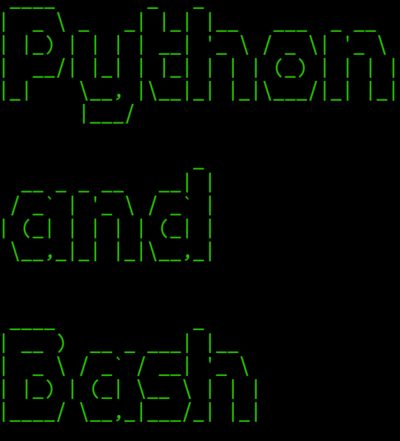Difference between revisions of "IoT Coding basics"
| Line 154: | Line 154: | ||
#import sys | #import sys | ||
| + | from random import randrange | ||
| + | |||
| + | theanswer=randrange(10) | ||
| + | |||
| + | print(randrange(10)) | ||
print "Seeking answers from the computerized 8 ball" | print "Seeking answers from the computerized 8 ball" | ||
Revision as of 03:08, 9 June 2020
Lab showing bash and python as well as execution times Provide some fix the code as well as complete the code examples. Dealing with numbers, printing them, division and decimals
Stuff about the languages
Contents
Hello World!
In this section, we will run Bash and Python hello world examples.
Bash
#!/bin/bash # This is a bash comment echo "Hello Bash World!"
Python
#!/usr/bin/env python3
# This is a python comment
print("Hello Python World!")
Use your favourite text editor to create these two files hello_world.sh and hello_world.py. Make sure you provide them with execute permissions
chmod 777 hello_world.sh
And
chmod 777 hello_world.py
You can execute them with
./hello_world.sh
And
./hello_world.py
The contents of the code should be prety straightforward. The only link that may need explaining is the shebang first line. The shebang line allows the script to executed like a standalone executable without typing python, ruby, et cetera. It also immediately tells someone looking at the code, what language has been used and in the case of python it can specify the version of python that is used to execute it.
Variables
Modify your current code using the following code snippets
Bash
a="Hello bash using variables" echo $a
Python
a="Hello Python using variables" print(a)
Make sure you understand everything before moving on.
Basic calculations
Lets add some calculations to our previous code:
Bash
a=10 b=5 c=$((a+b)) echo $c
Python
a=20 b=10 c=a+b print(c)
Run them both. Once you understand, I would like you to modify the examples so that you are familiar with subtraction, multiplication and division.
Modify the Code 1
Examine the following two code snippets written in Bash and Python.
Bash
#!/bin/bash for ((i=0;i<10;i++)); do echo $i done
Python
#!/usr/bin/env python3
for x in range(10):
print(x)
Modify each code snippet to print the square of each number in the sequence. So the output should look like:
0 1 4 9 16 25 36 49 64 81
Can you create an average of the numbers in the sequence? So the output should just be:
4.5 for python 4 for bash as it does not natively support decimal or floating-point numbers
Hacking together Bash and Python
Some times there are really great function or programs that you wish to run and get the output in your python code. So the code that you run within python could be anything C, Ruby, Bash, whatever we could normally run on the command line, we can run within Python (or bash but we will use Python example).
Lets start with a simple example. Type
date
on your Linux command line. Ok now lets work on getting this within our Python code. Look at the python example below.
#!/usr/bin/env python3
import subprocess
print("Hello Python World!")
subprocess.call("date")
Rune the code above and make sure it works. Sometimes we might want to get date into a variable:
#!/usr/bin/env python3
import subprocess
print("Hello Python World!")
result = subprocess.run(['date'], stdout=subprocess.PIPE)
print(result.stdout.decode('utf-8'))
theresult=result.stdout.decode('utf-8')
print("This is the result of date: " + theresult)
Upgrade the Python2 code
The following is a Simple python game, that reuses the random function from bash that we used earlier. The problem is that it was coded for Python 2. I want you to upgrade it so that it will work natively with Python 3. You will need to edit the shebang as well as the print statements
#!/usr/bin/python2
#import sys
from random import randrange
theanswer=randrange(10)
print(randrange(10))
print "Seeking answers from the computerized 8 ball"
if theanswer == 1:
print "Perhaps"
elif theanswer == 2:
print "Outlook good"
elif theanswer == 3:
print "Don't count on it"
elif theanswer == 4:
print "Hmmmmm"
elif theanswer == 5:
print "Focus and it will happen"
elif theanswer == 6:
print "It seems unclear"
elif theanswer == 7:
print "It is a certainty"
elif theanswer == 8:
print "Unlikely"
Glueing code together =
Glueing code together
- running Python from bash
- running bash from python
Code resiliency
Reving processes
Virtual Terminals
Complete some common Fibonacci or squares examples
